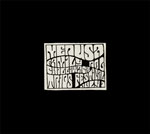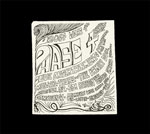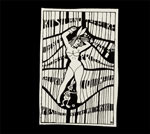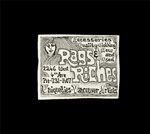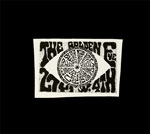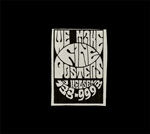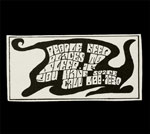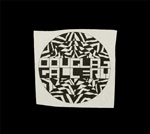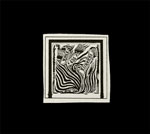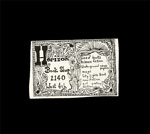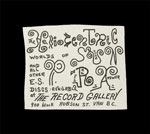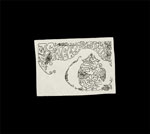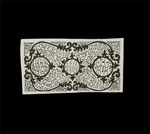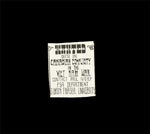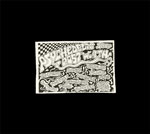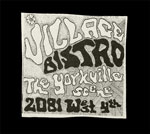
footnotes
In the fall of 1967 the newly-formed Intermedia Society for the exploration of art and technology opened its Beatty Street artists' workshop funded by the Canada Council. At the time, Intermedia's working strategy, an experimental, collaborative approach to art production, wasn't unfamiliar to the Vancouver art community. In deed Intermedia's cutting-edge relationship to the art scene was the continuation of a grassroots tradition of multi-media, interdisciplinary art activity which began at the Cellar Musicians and Artists Studio-Club in 1956. This tradition continued to develop over the next decade through a series of artists' initiatives including the New Design Gallery/Arts Club, UBC Festival of the Arts, blew ointment press, Sound Gallery/Motion Studio, the NE Thing Co, and the Georgia Straight newspaper. It was this grassroots "inter-media" movement which led to the formation of the Intermedia Society.
The Cellar Musicians and Artists Society (1956-1963)
In 1956 a small group of Vancouver Jazz musicians formed the Cellar Musicians and Artists Society. The nonprofit organization soon opened the Cellar Musicians and Artists Studio-Club in an inexpensive basement venue at Broadway and Main, in Vancouver's Mount Pleasant. A memorandum sent to club members following opening night in May 1956 states that: "the club was formed with the purpose of presenting modern music for those who can enjoy and appreciate it." On a typical Saturday night the intimate subterranean atmosphere of the Cellar reverberated with the bebop sounds of pianist Al Neil along with other Cellar musicians including core club members; basist Tony Clitherol, horn player John Dawe, guitarist Jim Kilburn, drummer Bill Boyle and sax players Dave Quarin and Jimmy Johnson. The jazz sessions would sometimes be accompanied by improvised poetry reading by Neil and others. From opening night these sessions were immensely popular, the memorandum offers apologies to members "if any of your friends were turned away on the opening night of 'jazz in the cellar'. If you were present you will no doubt realize that with the facilities we have available, it is impossible to accommodate a crowd anywhere near the size that appeared on Saturday night." From that point the Cellar policy was to limit the number of guests to one per member on Saturday nights.
Reflecting on the interdisciplinary nature of creative activity at the Cellar and its affect on the make up of regular audiences at the Cellar, Al Neil explains; "during that time there were like minded people around who were into doing modern drama it had to be almost on a guerilla basis. These were pre-Arts Club days— these theater people didn't have a place where they could do stuff on a regular basis." Except for Saturday night, jazz at the Cellar was closed to the public and used for practice and rehearsal space for member musicians. "My friend Barry Cramer asked if he could use the place to produce a number of Samuel Beckett plays: Waiting for Godot, End Game and the like — the current trendy plays of the time. They got an amazing response. We played a little jazz maybe a set because those plays weren't that long. We found we got a whole new audience this way. We made valuable contacts at the CBC (they were big on culture) who were quite surprised that Barry could put on a Beckett play that early, just a few years after it was written. The plays were favorable reviewed on CBC radio. People attended these drama events and when they realized what was going on at the Cellar— we had abstract paintings on the black walls and they heard a little jazz either before or after the play— they came back on Saturday nights for jazz and then became regulars".
The Cellar scene from 1956 to 1963 involving the presentation both separately and in combination of jazz, poetry, theater and visual art, marked the beginning of a grassroots movement towards a confluence of the arts in Vancouver.
David Orcutt (1956-1968)
By 1956 David Orcutt had relocated to Vancouver from the US, and was engaged in experiments using shadow puppets in conjunction with overlapping multi source projected imagery to develop short narrative sequences with he called "live animation". The recently opened west coast production facility of the CBC became interested in this work and hired him to preform these whimsical sequences, live, as station breaks throughout their broadcast day.
In 1960 Orcutt at the invitation of UBC,s Child Art Center Program, moved his studio into several quonset huts loaned to him by the university. Over the next several years he conducted workshops with children, where he explored the potential of the interactive use of media in art education. One technique which he developed in these workshops was the use of an opaque projector to enlarge the scale of a child's art work on to the wall, allowing them to interact with their work in pre-formative ways.
He also taught workshop participants to make there own filmstrips which they could animate using a special projector designed and built by Orcutt. Orcutt,s concern was that TV was creating a generation of passive viewers and through his interactive workshop activities in which which children actually engaged in elementary forms media production, he hoped to empower them to develop a more involved pro-active and creative stance with regards to TV and media in general.
Also in the early 1960's Orcutt began producing large-scale public auditorium events involving multiple-projection in conjunction with audience involvement. At the invitation of principle Fred Amos he staged a number of these events at the Vancouver School of Art.
In the fall of 1963, Sam Perry a UBC student with an interest in poetry and film making began spending time with Orcutt in his quonset hut workshop. Perry wanted to do film animation and found in Orcutt a resource of experience, ideas and support. In 1966 Perry emerged as a key collaborator in Sound Gallery events, where his film and image projections presented in combination with THEco dance performers, and the music of The Al Neil Trio would become a central spectacle of the burgeoning acid fueled 4th Ave hippy culture.
David Orcutt with his enduring enthusium for multi media exploration his interest in art and technology and the ideas of Marshal Mcluhan, was one of the original instigators of the notion of Intermedia in vancouver. In 1967 he was one of the societies founding members and functioned as the intermedia workshop's first project manager.
The New Design Gallery / The Arts Club (1958-1961)
In 1958, CBC producer Bob Orchard, recognizing that there was a need in Vancouver for an arts venue where people interested in all the arts might meet and socialize, contacted Alvin Balkind and Abe Rogatnick who he knew were anxious to move their New Design Gallery into Vancouver from its current location in West Vancouver. Together they came up with a plan to combine the New Design Gallery with a new Arts Club at one location. A number of other interested people joined them in this endeavor including artist Takeo Tanabi, writers Jane Rule and Helen Sonthoff, and architect Arthur Erickson. They rented a building suitable to house both the gallery and club. The new space, a former garage at 1157 West Pender, was configured as one large open space. The group designed and built an ingenious movable wall which could be positioned further into the Arts Club space to accommodate a large gallery opening or into the the gallery when the Arts Club was offering a theater performance, concert, or lecture.
Managed by Alvin Balkind, the New Design Gallery / Arts Club quickly became became an active center for the arts in Vancouver. It was also popular for its theme parties and its lunch menu for which a unique sandwich was designed daily by Balkind himself.
Along with theater and the visual arts the New Design Gallery / Arts Club presented films, concerts, lectures and poetry. Marshall McLuhan and Raymond Massey both made their first Vancouver appearance there. Warren Tallman organized readings by his beat poet friends from San Franrcisco including Lawrence Ferlinghetti. Al Neil and writer/poet Kenneth Patchen delivered a live preformance of their 1959 folkways recording; Kenneth Patchen Reads with Jazz in Canada with The Al Neil Quartet.
The UBC Festival of the Contemporary Arts (1961-1971)
Beginning in 1961, the UBC Festival of the Contemporary Arts became an annual Vancouver mid-winter cultural event which introduced enthusiastic audiences of students, artists , writers and the general art-public to the latest trends in the contemporary art world. Throughout the 1960's organizers of the Festival presented a procession of international avant guard luminaries such as filmmaker Stan Brackage, musicians John Cage and David Tudor, artists Bruce Conners and Robert Rauchenberg, dancers and choreographers Merce Cunningham and Jean Erdman, theorists Marshall McLuhan and Buckminster Fuller, poets Robert Duncan, Lawrence Ferlinghetti, Allen Ginsberg, Michael McClure, and Jack Spicer to name a few. The festival theater and dance productions were collaborative, interdisciplinary, experimental events often blending dance the spoken word, the visual arts, music, electronics, sound and light.
Many local visual artists dancers, musicians, writers and poets were also featured in the festival programs. This participation allowed Vancouver artists to form lasting professional associations with artists and performers with international affiliations, and in turn enabled them to forge connections with an international audience for their own work.
The idea for the festival originated within the newly formed UBC Fine Arts Department. The planning and preparation was done by a committee chaired by department head B.C. Binning and was composed at various times of Warren Tallman, English professor and writer; Helen Goodwin, dance instructor and choreographer; Abe Rogatnick, architecture professor; Alvin Balkind, director, UBC Fine Arts Gallery; Harry Adaskin, music professor and composer; Helen Sonthoff, English professor and writer; and Ian Docherty, music critic for the Vancouver Province newspaper (1957-61) and UBC Fine Arts coordinator (1960-66).
The Festival of Contemporary Art was well attended and Vancouver audiences, as a result of regular exposure to its avant guard presentations, developed an increased awareness accompanied by a growing acceptance of art that was challenging and unfamiliar. It was these same audiences, who would so readily embrace the unconventional production of Intermedia artists and provide the enthusiastic support which was so important in making Intermedia such an immense success in Vancouver.
blew
ointment press (1963-1969)
"By 1963 blew ointment press was beginning to provide a much needed voice to a quickly growing population, around 4th Avenue in Kitsilano, of disaffected, anarchistic left wing youth."
Poet, Maxine Gadd
"blew ointment was born of a sense that something had to change in the meager and very restrictive world of mainstream literary publishing in Vancouver. From the beginning blew ointment was wide open and inclusive....."
Poet, Judith Copithorne
For poet / painter bill bissett, blew ointment started out as a method of gaining an audience amongst his peers for his unconventional art work, which was an interweaving of his very personal hand rendered poetry and texts within the body of his paintings and drawings.
He was soon including the work of other young disenfranchised writers, poets and artists beginning to form a community on and around Kitsilano's 4th Avenue.
Issues of blew ointment were produced in bissett's studio using a Gestetner office duplicating machine. bissett, often with the the help of contributers to the magazine, would collate the hand printed pages with a wide variety of found material which might include pages from the phone book, newspapers, selected graphic illustrations from old textbooks and bissett's small daughter's drawings. These collated issues, covered and stapled, were ready for distribution within the community.
bill bisset continued to publish blew ointment, about 30 issues in all, along with some special issues, until 1969.
The Sound Gallery/Motion Studio (1965-1966)
The Sound Gallery began as an artists initiated project. This collective of painters, musicians, dancers, poets, and filmmakers, in reaction to restrictive, "official", definitions of acceptable art practice and the ever-increasing commodification of art, chose to experiment collaboratively with hybrid media in a storefront venue before an audience of their peers. The
Sound Gallery started out in the 4th and Bayswater studio of painter / musician Gregg Simpson and within a year it moved to a much larger location downtown on Seymour St. changing its name in the process to the Motion Studio. Drawing to a close in 1966, the Sound Gallery /Motion Studio initiative, had lasted just a little over a year. Even though relatively short lived, this grassroots initiative and the experimental, interdisciplinary performance events it had pioneered here had a definitive influence on the Vancouver scene. The Sound Gallery / Motion Studio experiment and its community of artists, poets, performers and their audience, provided the initial inspiration and impetus for the formation of the Intermedia Society.
The Sound Gallery/Motion Studio artists, poets, musicians and dancers (1966)
Richard Anstey
Judith Copithorne
Michael Coutts
Linda Crane
Maxine Gadd
Gerry Gilbert
Helen Goodwin
Doug Hawthorn
Al Hewett
Gary Lee Nova
Al Neil
Joan Payne
Sam Perry
Evelynn Roth
Ken Ryan
Dallas Selman
Gregg Simpson
Dennis Vance
Gerry Walker
Rita Watson
artist / hippie alliance (1963-1966)
In 1963 poet bill bissett's groundbreaking poetry and visual art magazine blewointment began printing and distributing: poems, philosophical writings and visual arts by a group of socially disenfranchised youth who had begun to hang out together on 4th Ave., in Vancouver's Kitsilano area. blewointment, by recognizing and endorsing the creative efforts of these young misfits, helped sustained them in their search for a cultural identity and sense of community.
In 1965 these same “pre-hippies" were showing up for the multi-media "happenings" held at 2953 W. 4th Avenue [link to photo of contemporary site], the store front studio of painter/ musician Greg Simpson. The studio which became known as The Sound Gallery was used by Simpson and a collective of his, artists; dancers; musicians; poets and film maker, friends as a venue for their experimental public performances. Even though several of the artists producing these collaborative, multi-media events were barely out of their teens at the time, their artistic roots wer in the late 1950's and early 1960's. Their work was strongly influenced by the San Francisco's beat culture of poetry and Jazz and New York's avant guard performance art scene. At the Sound Gallery and then later at the downtown Motion Studio, these two maverick groups: the post-hipster artists and the 4th Ave. proto-hippies, outwardly all but indistinguishable from each other, merged into a symbiotic relationship based on a shared taste in music, and psychedelic drugs. In their lifestyle choices both groups leaned towards social anarchy and had a profound interest in eastern religious philosophies and practices including various forms of Buddhism and Yoga.
This artist/hippie alliance, artist as producer and performer / hippie as audience and participant, contributed greatly to the on-going artistic success of the Sound Gallery/Motion Studio experiment. This alliance also played a key roll in the popularity and success of the three day trips festival produced by Sound Gallery/Motion Studio artists at the PNE’s Garden Auditorium. This festival was billed by promoters as “an electronic performance — Vancouver’s first festival of sound and light – an ecstatic new space total sense perception”
. This psychedelic style event featured performances and esoteric projections by Sound Gallery/Motion Studio musicians, artists, poets, dancers and film makers, along with The Grateful Dead and Big Brother And The Holding Company.
<-- back
cbc radio interviews Intermedia planning committee members – Victor Doray and Joe Kyle (April 21, 1967)
"It is our intention that Intermedia be a place where creative exploration could take place on an interactive basis between artists, between technologists and between seriously interested people."
"The only criteria that we have is that it is far out, creative and exploratory, relating most directly to our own Marshal McLuhan. It's very hard — I don't think it's very desirable to try and define intermedia in too great detail at the moment because it's exploratory we are in a sense discovering this thing into existence. We have tried in the setting up of this thing to create as unstructured an environment as possible. This is the essential difficulty involved in bringing this kind of thing into existence within the confines of an existing institutional structure."
13 min. 10 sec.
Journalists and Art Critics (1967-1970)
Kay Alsop
The Vancouver Province
James Barber
The Vancouver Province
Lawrence Cludreay
The Vancouver Province
Christopher Dafoe
The Vancouver Sun
John Driscoll
The Victoria Times Colonist
Ann Finkel
The Vancouver Province
Andre Genous
The Georgia Straight
Jurgen Hesse
The Vancouver Sun
Diane Janowsky
The Victoria Times Colonist
Joan Lowndes
The Vancouver Province
Ian Macdonald
The Vancouver Sun
Brian McLeod
The Vancouver Province
Ann Rosenberg
The Vancouver Sun
Olga Ruskin
Gastown Gazette
Andreas Schroeder
The Vancouver Province
Reg Silvester
The Victoria Times Colonist
James Spears
The Vancouver Province
Alf Strand
Bill Thomas
The Victoria Times Colonist
Charlotte Townsend
The Vancouver Sun
Norman Wilson
The Vancouver Province
Max Wyman
The Vancouver Sun
The Hippie underground and the Georgia Straight newspaper (1967)
The Georgia Straight newspaper, was formed in Vancouver in 1967 as a co-operative venture by a group of poets, political activists, and artists. This new community newspaper was seen as an underground alternative to the mainstream Vancouver papers which in the early months of 1967 had begun to routinely published articles which ridiculed and dehumanized hippies along with other seemingly non-conformist members of youth culture. As this conflict, between the Vancouver's general public and it's hippie community, intensified, the Straight became the cultural and political voice of Vancouver’s hippie community and it's youth culture in general.
Created in May 1967 by Georgia Straight staffers, these 16 advertisements and public notices from the second edition provide a candid glimpse into the quotidian life of Vancouver’s so called "counterculture". . .
Volume 1, No. 2, May 1967
Editors:
Rick Kitaeff; Dan Mcleod
Contributing Editors:
Jim “lobo” Tucker; Milton Acorn; Peter Hlookoff; Pierre Coupey; Chris Fahrni; T.F. Smith; St. Bernard.
Art & Layout:
Pete ‘Zipp’ Almasy; Mark Freeman; Steve Abrams; John Kelsey; Kurt Reichel; Anne Kitaeff; Aann Jung.
Photography:
Fred Davidoff
Typists:
various
Editor in Chief & Chairman:
Emmett W. Grogan
Intermedia dome show
(May 19-31, 1970)
INTERMEDIA MAKES WAVES
Brad Robinson
Arts Canada Magazine
June 1970
The primary metaphorical context of Vancouver is coastline and waves. Edges, particles, waves. Boundaries giving advantages to adventurous thought and the implementation of that thought in a field somewhat larger than the circumscribed individuality of the artist as a single figure, isolated and alone. The artistic experience of the city is a binding process involving, directly or indirectly, each citizen in it. An active interchange between artist, art and community, the delta redefining the boundaries, the sea likewise returning. The motion is eternal...
" ... a movement your eye may see..."
From Robin Blaser's poem
Bottom's Dream.
And as movement, as thirteen waves, the Intermedia Spring show was a congruent response to the experience of Vancouver. Drawing on the total resource of the city — from individuals to organizations to corporations — Intermedia put together a thirteen day long exhibit that moulded and unified these resources in a way both new and unique.
In many ways the show was extra-art, implementing talents not usually found or even sought out to reside in an art situation
A short catalogue to suggest: the Salvation Army Band, karate groups, topless dancers...
But the essential resource used was the audience themselves. Intermedia offered a space where there could be a fusion of energies, where the meeting of artist and audience could occur on grounds lacking pretense and where the two could work together in an energetic transference to create something, create an art, a tangibility that would shove around the boundaries of convention.
The contingencies of place, space and attitudes. The common denominator of assumptions: that all are human and that the category artist is a post-nomination after, and only after, the initial instance of being human.
To begin with that assumption Intermedia organized the space in the gallery with an eye to freedom of transit, where the ambulance of activity was given almost total access to the resource of space that gallery offered.
The only static objects of the entire two weeks were ten geodesic domes. Domes equalling homes, places to stay, or wander around, inspect, feel, touch and wonder about. Sited in each room of the gallery of domes, each an extension of a person, a personality, displayed this fact through the materials used in their construction.
Another catalogue: aluminum, foam, plywood, meccanno, papier- maché, vinyl...
The day as wave sweeping in at the shoreline predicated, urging new definitions of activity, new verbs....
Theater Night. Dada-surreal Seven Acts... no one quite sure if they got the seven acts off...#1. Throwing oranges at the audience. Audience returns gesture. #2. Under the big dome entire cast eats a meal of crab and saki. Throwing white flower around. Cast leaves, audience eats leftovers. Taste of saki. #3. Might have been the last act. Bicyles riding. Tandems. Wailing women wandering through the audiences, frantic music. Intensity of pitch dislocates. Where are we?
Dance Night. Helen Goodwin Dancers. Karen Rimmer up front. Under the main dome (aluminum tube) in eerie blue light struggling around the periphery of the dome.
AGON — Greek 'struggle for the prize.' Received in the next dance as the entire troupe unwinds white tape through and around the audience and as they pick it up and join the dance. All dancing, a sea of heads bobbing. People as verb. Activity. Non-object.
Poetry Day. Vancouver poets swoop upon the Gallery to read their work in smaller domes. Gerry Gilbert, quiet gentle suction of his magic. Judy Copithorne, singing, melos of word. George Heyman and Scott Lawrence, evidently Buddhist bhakti howling chants. Love of the divine graces from all.
At night the Vancouver Poetry Front operates word dramas in the big dome. Wild, madly funny parody of melodramatic love. Gerry Gilbert satire of heartsick lover a precision of balance. Great comedy.
First Film Night. Energy flags for the first time. perhaps because of the demand of single attention, less mobility of action. Yet Dave Rimmer's Variation on a Cellophane Wrapper comes through as a masterpiece. To be seen again and again. A confirmation that the concentration on the particle will summon forth a multiplicity of meaning. An escalator of statement and technique dragged out of a film loop.
Al Neil Trio. With Gregg Simpson on drums and Neil's wife Marguerite on violin. Space Music. Neil,s brilliant command of the piano is perhaps unmatched except by only the most highly trained. But do they have his imagination, his intelligence, his innovative and creative powers? Marguerite Neil the first real goddess to make an appearance on the B.C. coast.
Like the great sitarists, Neil's technique is so highly developed that he can catch on the piano all that his inner ear whispers to him. The primary improvisatory demand.
How much longer can this music be ignored by other than Vancouver audiences?
City Feast. Singular. A true Bacchanalian rite beginning in private homes throughout the city. Eating, drinking, priming.Converging at the gallery at nine, meeting with others. Close to a thousand people, drinking, waiting till the band starts. People as an infinite verb. A stasis of energy, quiet enjoyment. And then all the people began to wildly exuberantly joyously dance. the infinite spilt. Bad Grammar. The explosion that makes all boos irrelevant that say so.. Michael de Courcy shaking his head in amazement. Topless dancer writhing high above the dancers. The dancers writhing. the energy released is not dissimilar to that of a split atom. A benevolent explosion in which the entire exultancy of spirit establishes the event as a work of art — a living organism alive and mutually harmonious.
The final evening was a total success that changed as many peoples perceptions as any other work of art with the significant difference that it was the people themselves who made the art.
In many instances, this was the case throughout the entire show. It was the attentions of Intermedia and the subtle organization and planning of the group that made the entire show such a success as a dialogue with 8528 people who in return gave Intermedia tactile approval from their point of view to continue in their adventures.
To make more waves. A wavering that our eyes might see...
Arts Canada Magazine
June 1970
